7 THE GUNDOG FROM BRITTANY
THE GUNDOG FROM BRITTANY
by David Hancock
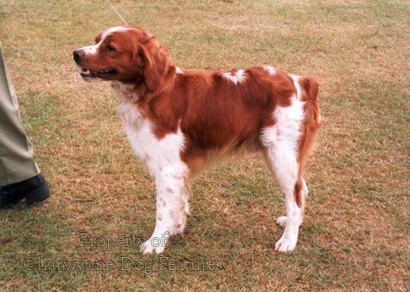 The quite astonishing rise in popularity in Britain of the gundog breeds which hunt, point and retrieve has seen their numbers advance from just over five hundred annual registrations some thirty years ago to well over 7,000 nowadays. The early registrations however featured just two breeds, the German short-haired pointer and the distinctive Weimaraner, both breeds having impressed British servicemen in Germany. But the current list shows twelve different breeds, with the pointer-retrievers from Germany making up the bulk of those registered. One relative newcomer in that list is the Brittany or more accurately l'epagneul Breton, for the continental epagneul breeds, setter-retrievers in our terminology, should never be called spaniels if they are to be fully appreciated and correctly used in Britain. Slightly smaller than an English springer spaniel, with a Welsh springer look about them, Brittanys can be orange and white, liver and white, black and white, roan or tricolour. The brown roans look very much like the small Munsterlander and the black roans like the Stabyhoun of Holland, with one significant difference: the Brittany has a short tail, an unusual feature in an epagneul breed. This may save damage to the full tail which dense cover can inflict but most other breeds of this type: epagneul Picard, epagneul Francais and epagneul bleu de Picardie feature the full tail whilst the epagneul Pont-Audemer has a shortened tail. With the latter breed coming from Normandy, excelling on woodcock and being chestnut and white, it could well have more in common with our own more specialist springers.
The quite astonishing rise in popularity in Britain of the gundog breeds which hunt, point and retrieve has seen their numbers advance from just over five hundred annual registrations some thirty years ago to well over 7,000 nowadays. The early registrations however featured just two breeds, the German short-haired pointer and the distinctive Weimaraner, both breeds having impressed British servicemen in Germany. But the current list shows twelve different breeds, with the pointer-retrievers from Germany making up the bulk of those registered. One relative newcomer in that list is the Brittany or more accurately l'epagneul Breton, for the continental epagneul breeds, setter-retrievers in our terminology, should never be called spaniels if they are to be fully appreciated and correctly used in Britain. Slightly smaller than an English springer spaniel, with a Welsh springer look about them, Brittanys can be orange and white, liver and white, black and white, roan or tricolour. The brown roans look very much like the small Munsterlander and the black roans like the Stabyhoun of Holland, with one significant difference: the Brittany has a short tail, an unusual feature in an epagneul breed. This may save damage to the full tail which dense cover can inflict but most other breeds of this type: epagneul Picard, epagneul Francais and epagneul bleu de Picardie feature the full tail whilst the epagneul Pont-Audemer has a shortened tail. With the latter breed coming from Normandy, excelling on woodcock and being chestnut and white, it could well have more in common with our own more specialist springers. 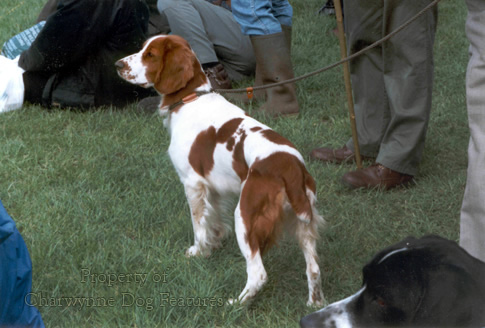
I have read articles claiming a common descent for Welsh springers and Brittanys, some theories being based on the portrayal in the Bayeux tapestry of Harold taking a red-coated hunting dog to France. On similar lines there are many who believe that the Brittany hound is really a Welsh hound taken there by Welsh colonists. There is no doubt that red-coated spaniel-like dogs were used in hawking and fowling, with the chien oysel of early medieval times likely to have been the forerunner of all our spaniel, setter and setter-retriever breeds. More than one breed from Brittany has developed a distinctive appearance, the chestnut basset (fauve de Bretagne) being very different from the other breeds of basset hound. For many centuries the Celtic and British influences were stronger in Brittany than Frankish. Brittany was, in the Middle Ages, known as Lesser Britain to distinguish it from Great Britain and this Celtic-speaking province kept its own rulers during what was only nominally Frankish rule. Politically and culturally, the cross-channel links are strong, with many centuries of trade including the movement of useful dogs being conducted. The first time I saw an epagneul Pont-Audemer I thought it was an Irish Water/Sussex Spaniel cross and it is forgiveable to confuse a Welsh Springer with a Brittany, although the red of the former is appreciably darker and richer.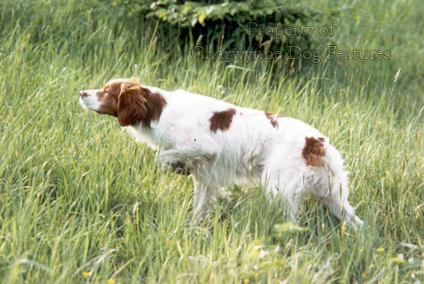
These French breeds are both distinctive and individual and should never display the 'type' shown in our setter breeds. One leading American expert on the breed has compared the Brittany to "a good riding cob, short-backed, full of fire and go, neither nervous nor high-strung, the epitome of stamina and carrying power for his size". And it is in America that the Brittany has made the greatest advance outside its native province, mainly as a field dog. The American Brittany club, formed as long ago as 1942, dropped the noun spaniel from its title, recognising that the misleading translation of epagneul as spaniel could bring misuse in the shooting field. (How I wish we ourselves would drop the noun spaniel from our Irish water spaniel breed-name, for it has and always will be a water retriever.) By 1972 there were over 100 dual champions in the United States and from 7,600 registrations in 1965 their popularity grew so fast that in the next five years this total had just about doubled. But whether established in America or just becoming appreciated in the United Kingdom, the Brittany is essentially a working dog but one not thriving in kennels. As a breed they need the attention of one owner to develop best and regular field work to bring out their full personality and spirit. Nearly two hundred years ago the breed was known as 'le fouguere', the high-spirited one, in the Callac area of Brittany. A French breeder called Arthur Enoud is usually credited with establishing the classic orange (known as 'tabac' in France) and white colour combination. The story goes that the breed originated in the middle of the last century from a highly-talented hunting dog, born tailless, and so impressive in the field that visiting British sportsmen used him on their English, Irish and Gordon setters, some of which remained in Brittany in the hands of local hunters. This is held to account for the range of colours found in the modern breed, although black is not acceptable in the United States. Perhaps less romantically I am inclined to think that this range of colours existed in the setter-like gundogs on the continent well before the middle of the last century, as the contemporary epagneul breeds display in Holland and Germany, as well as France. But there is no doubt that these tailless setters hunted the wind in great style and made their name in their own way with sportsmen.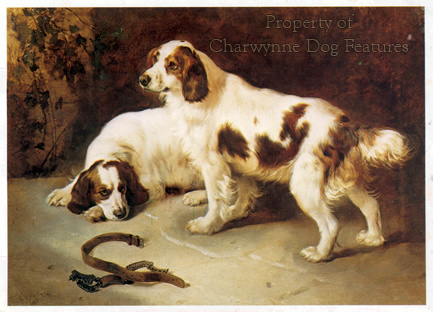
In 1907 the "Short-tailed Brittany Spaniel Club" was formed in France and the breed has gone from strength to strength despite the setbacks created by two world wars. In 1981, gundog fancier W.C.Stanley Smith imported a dog and two bitches from well-chosen, unrelated, continental stock and a year later a further young dog puppy to establish sound breeding lines in Great Britain. In Ireland, Michael Horgan and George Kingston of County Cork have also imported excellent stock from France. In March 1981, I wrote an article in Shooting Times on the Brittany and ended, to the scorn of the hidebound gundog writers, by saying that I could see them, once introduced, becoming immensely popular and highly successful in field trials. In that year no registrations were made here; in 1982 nine were registered and by 1988 over 50 were listed, with 158 registered in 2008. Angela Lewis, known previously as a Welsh Springer enthusiast, bred and handled the first Brittany field trial champion in the country, her 4 year old bitch Riscoris Fleur de Lys. Mr W Thayne had a willing little bitch, Victoria of Talwater, running well and Bert Young, a Dorset gamekeeper, proved a successful trainer of a breed which requires a rather different approach to their training. The breed has been criticised for being too spirited, carrying its nose too low, ranging too wide and being too small to retrieve a hare in trying country. But it has to be appreciated that this breed has a style of its own, a marked individuality and is different. I am pleased to learn that the Brittany Association in Great Britain has rules which closely follow those of the club in its native land. Every puppy is tattoo'ed with a number which registers the dog with the association.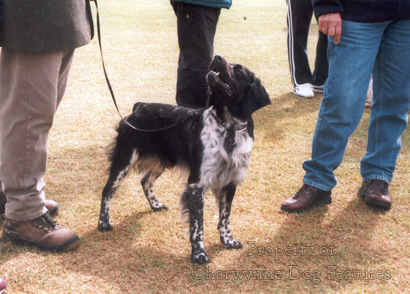
Each purchaser of a puppy must sign an agreement to train and work or field trial their purchase. As fast as any setter, the Brittany, being shorter-coupled, has however a different style of movement which has been described as a "short gait", appearing to flow over the ground rather than gallop. I am told that the French owners often used their dogs for poaching and therefore favoured stealthily-moving dogs with a low crouch on point. American owners prefer a wide-ranging dog with greater self-reliance, depending less on the handler. In French trials the dogs are trained to lie down on the approach of the handler to the dog's point. It would be foolish for any sportsman to consider buying a Brittany without first learning about the style, instincts and idiosyncrasies of the breed. We bred out the versatility in many of our own gundog breeds, going for pointers which only point and retrievers which only retrieve. We so often forget that our pointers were originally required to retrieve too. Brittanys have great reserves of energy, respond only to gentle handling and have gained a reputation for keeping going on the longest day in the field. Ideally they need a handler as intelligent as they are! Not over-feathered and with ears of a sensible shortness for field work, leggier than our spaniels but shorter-backed than our setters, with a smooth, fluid, light-footed gait, this is a versatile, adaptable breed for the sporting owner aware of their traditional method of operating in the field. I foresee a bright future for the Brittany in the United Kingdom. There is economic sense in having a gundog weighing only 30lbs or so which can hunt, point and retrieve. All true dogmen admire spirit in a working dog and harness it for good. And all true sportsmen respect real shooting as a genuine sport, demanding hunting skills and knowledge of wind, ground and game...rather than an indulgence for mere marksmen with guns waiting for the beaters to do their stuff. We have made so many of our native gundog breeds into limited specialists serving spoilt pseudo-sportsmen; perhaps hunting dogs like the Brittany can help us to find our way once more.